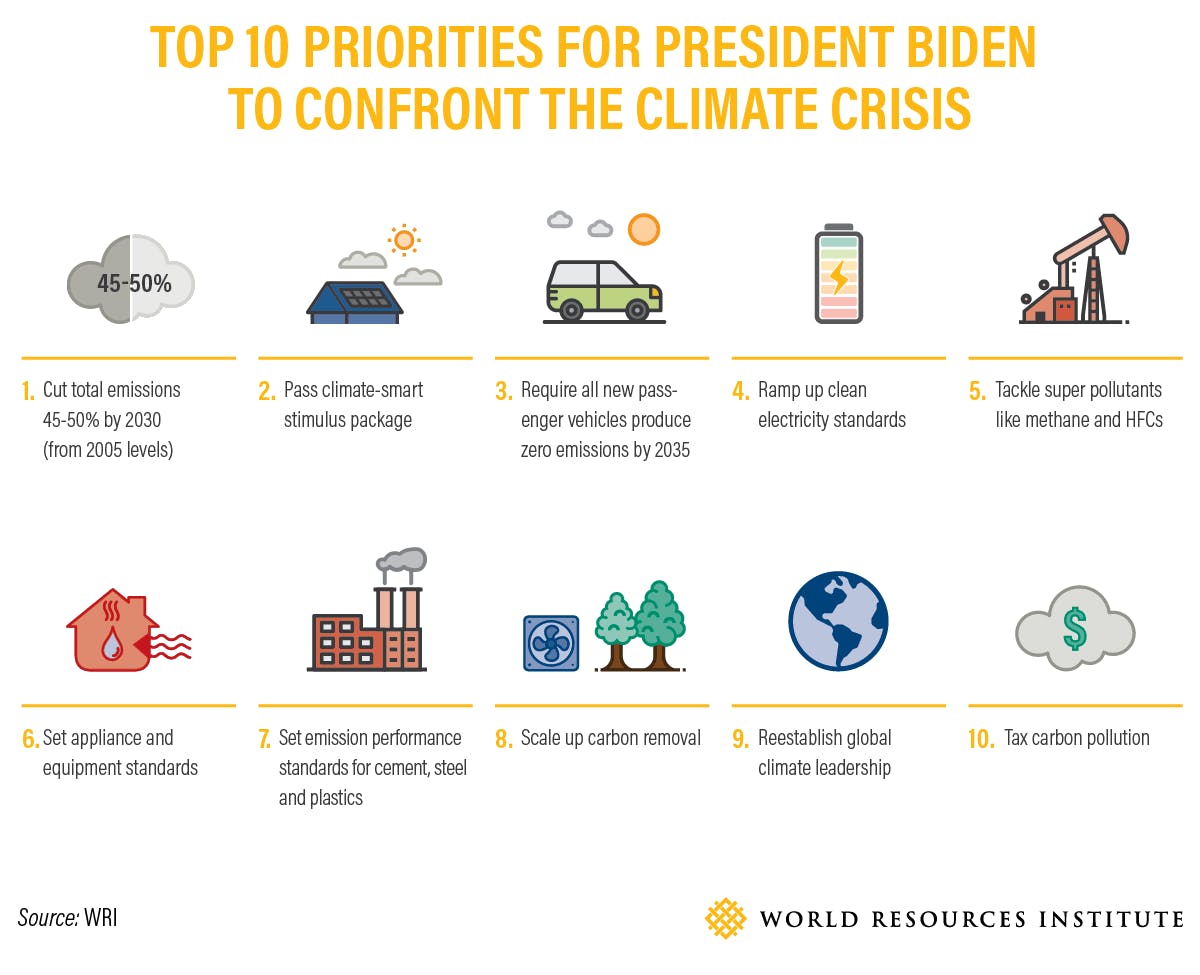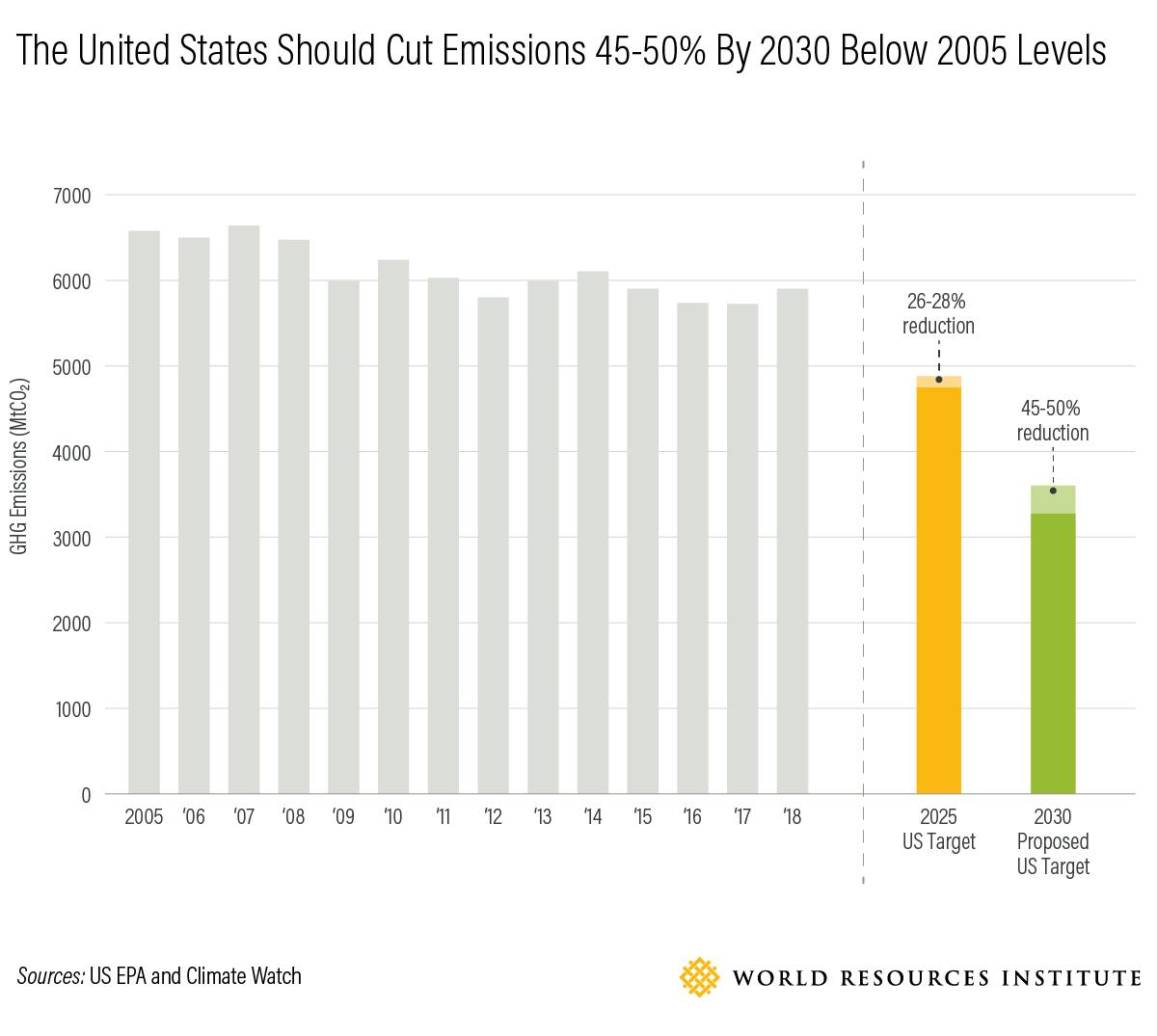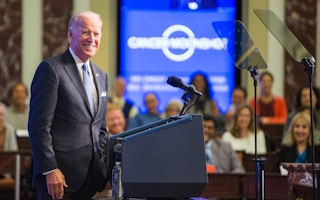President-elect Biden will be sworn into office in the midst of four deeply intertwined crises: the health crisis, the economic crisis, the racial injustice crisis, and the climate crisis.
He has promised to build back better by taking bold action on all four simultaneously, including making unprecedented investments in health care, infrastructure, and clean energy.
During the last economic crisis, some political advisors urged elected leaders to defer climate action and focus first on health care and the economy, which were seen as more immediate and politically popular concerns. That’s not viable this time.
The climate crisis is here now, and action is urgently needed.
“
The Biden administration will have its work cut out for it to repair damage done by the Trump administration, which pursued a deregulatory, pro-fossil-fuel agenda with a vengeance.
The political landscape has also shifted as the effects of climate change hit home and young people mobilise to demand a response that matches the scale of the problem.
It is now clear that climate change is taking a tremendous toll on our economy and threatens the stability of our financial system. On the other hand, the economic benefits and job opportunities from taking climate action are now much more widely recognised.
Despite the coronavirus pandemic, climate change featured more prominently during this campaign than during any previous election cycle. Indeed, it’s a hard issue to ignore when record wildfires tear through the West while so many named tropical storms buffeted the East that the Weather Service used up the Roman alphabet and had to resort to Greek letters.
The Biden administration will have its work cut out for it to repair damage done by the Trump administration, which pursued a deregulatory, pro-fossil-fuel agenda with a vengeance.
The Trump administration has attempted to reverse more than 125 environmental rules. It has worked to systematically sideline scientific and environmental experts in favor of industry executives and lobbyists, eroding the capacity of the Environmental Protection Agency (EPA), the Department of Interior, and other government agencies that are supposed to serve the public interest.
Hundreds of measures will be required to not only reverse the Trump administration’s rollbacks of environmental safeguards, but to roll forward an agenda that meets the challenge.
There is no dearth of ideas about what should be done. In addition to his own climate platform, Biden will be able to draw on comprehensive reports from the House Select Committee on the Climate Crisis and the Senate Democrats’ Special Committee on the Climate Crisis, as well as dozens of proposals from non-governmental organisations.
To be successful, however, Biden will have to set priorities and zero in on a set of high-impact measures that he can implement through executive action or push through Congress in addition to pursuing an expansive climate action plan. Biden’s climate priorities should be guided by three overarching principles:
3 Principles to Guide A New Era of Climate Action
-
Inclusive prosperity: Smart climate policies can not only reduce damages from unabated climate change, but also unlock massive opportunities for economic growth and reduce inequality, as documented in the America’s New Climate Economy report. The challenge now is to design policies that seize this opportunity and advance economic and racial justice, as well as build support among a diverse set of stakeholders powerful enough to put these policies into action.
-
Follow the carbon: Success must be measured by progress in reducing emissions, not just by dollars spent. Systemic change is needed in the sectors responsible for the bulk of US heat-trapping pollution. That means increasingly focusing on transportation and industry while accelerating ongoing progress toward decarbonising the power sector.
-
All hands on deck: During the last four years, leadership on climate change has, out of necessity, come from state and local governments and the private sector. As the Biden administration pursues its ambitious climate agenda, we cannot afford to lose any momentum among subnational actors. It is essential to design policies that empower, support and complement action by states, cities and companies, while establishing ambitious national targets and providing resources that can only come from the federal government.
10 Priority Actions to Curb Climate Change in the United States
To implement his plan for a clean energy revolution and environmental justice, Biden should focus on these 10 priority actions, drawing on the principles above:

Top 10 priorities for President Biden to confront the climate crisis. Image: World Resources Institute
1. Commit to cut total greenhouse gas emissions 45-50 per cent by 2030.
Biden’s campaign platform called for achieving zero emissions from power plants by 2035 and reaching net-zero emissions economy-wide by 2050. He should reiterate these targets as president and add a 2030 target to drive near-term ambition across all sectors.
Biden should adopt a well-grounded, but ambitious 2030 target in the range of 45-50 per cent below 2005 levels, based on the analysis in the 2019 Accelerating America’s Pledge report. This would require the Biden administration to establish strong federal policies that build on and complement leadership exercised by states, cities, and the private sector.
The lower end of this range is the minimum US reduction consistent with the Paris Agreement goal of limiting warming to 1.5 degrees C. The upper end would do more to help the United States reestablish a position of leadership in international negotiations, but would almost certainly require Congress to enact significant new climate legislation.

The US should cut emissions 45-50 per cent by 2030. Image: US EPA and Climate Watch
2. Pass a major climate-smart stimulus package to build back better from Covid-19.
Biden has proposed $2 trillion of climate-smart investments to stimulate the economy, create jobs and grow America’s clean energy industry, which would dwarf those made through the 2009 economic recovery package.
While Biden may not be able to get the entire package through a divided Congress, he will have significant leverage to insist that his priorities are included in must-pass legislation.
WRI outlined a series of high-leverage priorities to modernise our electricity grid, electrify school and transit buses, improve our transportation system, upgrade public schools, promote industrial innovation and restore trees to the landscape.
In addition to ensuring that at least 40 per cent of the funding benefits disadvantaged communities, as Biden has pledged, these investments should be designed to catalyse progress toward both short-term and long-term emissions-reduction targets.
That means not only deploying cost-effective technologies we have in hand, such as solar, wind, heat pumps and electric vehicles, but also investing in the future. The country needs a robust program to develop a portfolio of technologies for the decades that follow, such as enhanced geothermal systems, clean hydrogen and zero-emissions steel.
3. Require all new passenger vehicles sold after 2035 to produce zero emissions.
The cost of electric vehicle batteries dropped 87 per cent in the last decade. New electric vehicles are expected to reach price parity with similar combustion engine vehicles by 2025 or even sooner.
In September 2020, California Governor Gavin Newsom signed an executive order directing the California Air Resources Board to set standards phasing out the sale of polluting passenger vehicles by 2035.
Buses and most other medium- and heavy-duty diesel vehicles can also be electrified, as called for in the Zero Emission Medium- and Heavy-Duty Vehicle Initiative signed by 15 states in July 2020, which would help reduce the disproportionate pollution burden borne by low-income communities and communities of color. Biden should issue an executive order directing the EPA to set similar national clean car and truck standards.
4. Ramp up clean electricity standards to 55 per cent by 2025, 75 per cent by 2030, and 100 per cent by 2035.
Abundant clean electricity is essential — not only to eliminate pollution from all power plants by 2035, as Biden has committed to do, but also to decarbonise transportation, buildings and much of industry.
A study published by the Goldman School of Public Policy at UC Berkeley shows that recent dramatic reductions in the cost of solar panels, wind turbines and lithium-ion batteries mean we can achieve a clean, reliable and affordable electricity system much faster than previously believed if supportive public policies are put in place.
These policies would be more durable if enacted through bipartisan legislation, but could also be adopted through regulations under the Clean Air Act. They should require reductions in pollution affecting frontline communities as well as ensuring that national targets are met.
5. Tackle super pollutants.

Highly potent short-lived climate pollutants in the US. Image: World Resources Institute
One bright spot for bipartisan cooperation during 2020 was the consensus reached on federal legislation to implement the Kigali amendments to phase down production and use of HFC “super pollutants.”
Pound-for-pound, these greenhouse gases commonly used as refrigerants and more can have thousands of times the heat-trapping impact of carbon dioxide. If this legislation is not enacted before he assumes office, Biden should ask Congress to pass it swiftly next year.
Methane, the main component of natural gas, also traps far more heat than carbon dioxide on a pound-for-pound basis. The Biden administration should quickly reinstate and strengthen Obama-era EPA and Interior Department rules to curb methane leaks.
6. Set appliance and equipment standards to replace fossil fuels with electricity whenever feasible.
Almost 12 per cent of US carbon dioxide emissions come from burning fossil gas, oil or propane in our homes and other buildings for heat and hot water. These emissions could be cost-effectively eliminated in most cases by requiring the use of electric heat pumps when appliances need to be replaced.
Building codes should encourage new construction to go all-electric, saving money by not installing gas lines to begin with, as more and more cities are requiring. Some builders are reluctant to embrace this step because they think consumers want gas stoves.
It is worth noting, though, that the health impacts of burning gas in the kitchen are a growing concern. New induction cooktops, like those used in the Great British Baking Show tent, can boil water faster and offer more precise temperature control than gas.
Much of the low- and medium-temperature heat needed in industry can also be supplied by electric heat pumps, microwaves or other technologies, depending on the application, reducing local pollution as well as carbon dioxide emissions.
7. Set emission performance standards for cement, steel, and plastics.
Some of the largest industrial sources of carbon dioxide involve emissions from chemical reactions in addition to fuel combustion for boilers and high-temperature heat. A variety of innovative techniques are under development to reduce, eliminate or even reverse these emissions. But in some cases, the best approaches are not yet clear and may not even have been invented yet.
Given these circumstances, the Biden administration should work with Congress to provide substantial funding for research, development and demonstration projects. The administration can also use the federal government’s purchasing power to create markets for clean products and set technology-neutral emissions performance standards that get stronger over time.
8. Scale up carbon dioxide removal.
In addition to reducing direct emissions from sources as quickly as possible, it is increasingly clear that the United States will need to remove billions of tons of carbon dioxide already in the air to compensate for past emissions and sources that are extremely difficult to eliminate (such as methane emissions from cows, nitrous oxide emissions from farms, and carbon dioxide emissions from airplanes).
Without carbon removal, the United States will not be able to do its share to keep global temperature rise to 1.5 degrees C (2.7 degrees F), the limit scientists say is necessary for averting the worst impacts of climate change.
A natural way to capture carbon is to increase the number of trees on the landscape, whether in forests, agroforestry systems or urban areas. But there is a limit to the total amount of carbon we can sequester in trees and soils given the need to produce enough food to feed the growing global population.
That means we also need to develop technological approaches, such as direct air capture and carbon mineralisation. WRI’s CarbonShot project outlined a set of federal policy priorities to scale up a broad portfolio of carbon dioxide removal options.
9. Reestablish international leadership.
In addition to immediately rejoining the Paris Climate Agreement, as Biden has promised to do, he should elevate climate action to the top tier of US foreign policy. Well before the Glasgow climate conference scheduled for November 2021, the Biden administration should submit a new national climate plan to the United Nations that includes a top-line target of reducing emissions 45-50 per cent below 2005 levels by 2030.
In addition, he should deliver the $2 billion outstanding from the United States’ 2014 pledge to the Green Climate Fund and make a new pledge to the Fund in line with other countries’ ambition.
Biden should also use heads-of-state meetings, such as the G7 and G20, to advance international cooperation and work with our allies to establish a large-scale mechanism for financing climate-smart infrastructure projects in developing countries.
10. Tax pollution.
Last, but not least, no climate policy is complete without a mechanism for holding emitters accountable and ensuring that science-based emissions reductions are achieved by ratcheting up the price on carbon if other measures are falling short.
While some climate policy platforms focus primarily on carbon pricing and others dismiss market mechanisms as ineffective or even counterproductive, WRI research shows that carbon pricing must be an integral component of an effective climate plan.
While it’s unclear when the votes may line up to get carbon pricing through Congress, Biden should make the case that it is better to tax pollution than jobs and look for any opportunity to advance this key component of climate policy.
Use Every Tool in the Box to Fight Climate Change in the US
By taking the 10 actions outlined above, Biden can build back better from the Covid-19 pandemic and position the United States to achieve a safer and more prosperous net-zero future.
Given the magnitude of the climate crisis and the speed with which we need to transform major systems to cut emissions 45-50 per cent within a decade and 100 per cent by mid-century, we will need to use every tool at our disposal:
-
Standards are essential to prevent the construction of new highly polluting sources like fossil fuel boilers and transform the largest-emitting sectors.
-
Investments are essential to create jobs, build infrastructure and accelerate the transition to a zero-emissions economy.
-
Justice is essential to rectify the disproportionate pollution burdens imposed on Black, Indigenous and People of Color for generations and create the social cohesion needed to carry out this transformative agenda.
-
Pricing carbon pollution is essential to reinforce the effects of standards and investment, accelerate the retirement of existing pollution sources, influence millions of dispersed decision-makers simultaneously, and enforce emissions-reduction targets.
It will be a monumental task for the Biden administration to undo the damage from the Trump administration and catapult the country forward. Biden will have a historic opportunity that will not come again. He will need to exercise leadership and discipline to succeed.
My hope is that the 10-point plan outlined here can help focus his attention on the measures that will make the biggest difference. One thing is clear: There is no time to waste. Climate action must be a priority from day one.
Dan Lashof is Director, US of World Resources Institute. This post is republished from the WRI blog.











